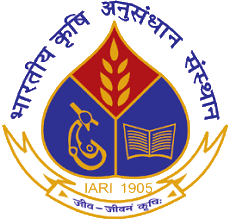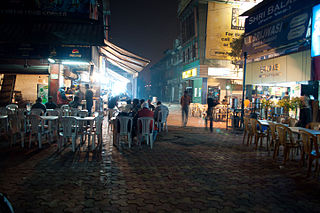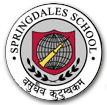Related Research Articles

The Indian Agricultural Research Institute (IARI), commonly known as the Pusa Institute, is India's national institute for agricultural research, education and extension. The name Pusa Institute is derived from the fact that the institute was originally located in Pusa, Bihar as the Imperial Institute of Agricultural Research in 1911. It was then renamed as the Imperial Agricultural Research Institute in 1919 and following a major earthquake in Pusa, it was relocated to Delhi in 1936. The current institute in Delhi is financed and administered by the Indian Council of Agricultural Research (ICAR). The IARI was responsible for the research leading to the "Green Revolution in India" of the 1970s. IARI ranked First among Agriculture and Allied Universities in the National Institutional Ranking Framework NIRF,

Karol Bagh is a neighbourhood in Central District of Delhi, India. It is a mixed residential and commercial neighborhood known for shopping streets, such as the Ghaffar Market and Ajmal Khan Road.
Ramakrishna Puram popularly known as R.K. Puram, is a residential colony in Delhi. Named after the saint Sri Ramakrishna, it houses many high-profile corporate houses.

Kamla Nagar is a residential and commercial neighbourhood in North Delhi, India. It is one of Delhi's major shopping centres.

The Inner Ring Road refers to one of the two main ring roads, the main inner one and an outer one in Delhi, India. The two ring roads have a combined length of 87 km (54 mi). There are two less significant Ring Roads in Delhi apart from the above two, namely the Rural Ring Road, that runs across the rural areas on the fringe of North West Delhi and West Delhi Ring Road, limited only to the West Delhi region.

New Friends Colony is a posh residential colony of South East Delhi, India. It consists of A, B, C, D Blocks. It is situated near Uttar Pradesh border.
Gulabi Bagh is one of the oldest and planned residential areas that lies north of central Delhi, India, adjacent to Ashok Vihar, Shakti Nagar, Kamla Nagar, Karol Bagh. Famous for its greenery and fresh air, it is often characterized by its famous (monkey) park that is adjacent to it.
The Delhi Tamil Education Association Senior Secondary Schools are eight secondary schools located in Delhi, India.

The Springdales Schools are a group of English-language, co-educational schools run by the Springdales Education Society in New Delhi, India. There are five branches of the school: Pusa Road, Dhaula Kuan, Jaipur, Kirti Nagar, and Dubai. They have produced a long list of alumni in the field of arts, business, science, military and civil service. The school completed their Golden Jubilee in the year 2005. The schools are affiliated to the Central Board of Secondary Education (CBSE).The Pusa Road branch was inaugurated by former Indian president Dr Zakir Husain.The school motto, 'Vasudhaiva Kutumbakam', is a Sanskrit phrase which roughly translates to 'The world is a family'.
The Civil Lines is a residential area and one of the 3 subdivisions of the Central Delhi district of Delhi in India. It is one of the 12 zones under the Municipal Corporation of Delhi. It was the hub of European-style hotels in the city until New Delhi came into being in 1911. The official residence of the Lieutenant Governor of Delhi is also located at Raj Niwas Marg, Civil Lines.
Malviya Nagar is a residential locality in South Delhi with property prices over 17,000 per sqft. Situated between Saket and Hauz Khas and close to IIT Delhi, its namesake is the freedom fighter Madan Mohan Malviya.
Patel Nagar is one of the 3 sub-division of the West Delhi District in India.

Rajendra Nagar is a residential colony in Central Delhi, Delhi, India. The name comes from Dr. Rajendra Prasad, the first president of India. It is bordered by the Central Ridge Protected Forest on the east and south, IARI on the west, and Karol Bagh on the north. It is a constituency in the Legislative Assembly of Delhi. The current Councillor for the Municipal Corporation of Delhi is Aarti Chawla of Aam Aadmi Party.

Karol Bagh Metro station, known as Drishti IAS Karol Bagh metro station, is a terminus station located on the Blue Line of the Delhi Metro. Karol Bagh is a residential and commercial area located at Delhi. This metro station of Delhi Metro was inaugurated in year 2005. Its adjacent metro stations on the Blue Line are Jhandewalan and Rajendra Place.
Naraina Vihar is a residential locality in South West Delhi. It is composed of flats built by the Delhi Development Authority (DDA) and privately built houses. The neighborhood is connected with Delhi Metro by Naraina Vihar station.
East Patel Nagar is a region of Central Delhi. It covers the eastern part of the Patel Nagar area. Among the three divisions of Municipal Corporation of Delhi, North, South and East, East Patel Nagar falls under Municipal Corporation of Delhi-North.
South Patel Nagar is a place in Central Delhi. It covers the Southern Part of the Patel Nagar Area. In the past South Patel Nagar was counted in Central Delhi but due to the continued city expansion, South Patel Nagar and its subdivision colonies like New Ranjit Nagar now come under West Delhi. However, among the three divisions of Municipal Corporation Of Delhi(MCD), North, South and East, South Patel Nagar falls under MCD-North.
Salwan Public School is a public school in New Delhi, India. This school has 10 branches: Salwan Boys Sr. Sec. School, Rajendra Nagar(1949), Salwan Girls Sr. Sec. School, Rajendra Nagar (1950), Salwan Public School, Rajendra Nagar(1953), Gyan Devi Salwan Public School, Rajendra Nagar(1990), Salwan Public School (Afternoon), Rajendra Nagar (1991), Salwan Junior School, Naraina (1993), Salwan Public School, Mayur Vihar, Phase III (1996), Salwan Public School, Sector 15(II), Gurugram (1996), Salwan Montessori School, Sector 5, Gurugram(1999) and Salwan Public School, Trans-Delhi Signature City, Ghaziabad (2005). The Old Rajendra Nagar branch was the first branch that was launched, and is an important landmark in the Rajendra Nagar and Karol Bagh localities. The Mayur Vihar branch was listed as second among the top ten schools in East Delhi, in 2012.
Vandemataram Marg is an arterial road in New Delhi, India. It runs through the central section of the Delhi Ridge and connects Karol Bagh to Dhaula Kuan. It was earlier called Upper Ridge Road, frequently shortened to Ridge Road, and is still often referred to by this name. For most areas of North Delhi, the shortest route to Delhi airport lies through the entire length of Vandemataram Marg. It stretches in a south-westerly direction from a roundabout at its northern (north-eastern) end, where it meets with Pusa Road, Arya Samaj Road, Faiz Road and Link Road, to Dhaula Kuan crossing at its southern (south-western) end. The Airport Express line of the Delhi Metro runs overhead along a 2km stretch of the road. Running through a forested area, Vandemataram Marg has been called "the greenest road of Delhi".
References
- ↑ Roy, Sidhartha (25 July 2014). "Chaos rules this commercial corridor". The Hindustan Times. Retrieved 16 January 2021.
- 1 2 Baruah, Sukrita (1 June 2019). "Agri research institute shifted to Delhi: Behind Pusa Road name, link to 1934 Bihar earthquake". The Indian Express. Retrieved 16 January 2021.
- ↑ "A tale of two cities". Hindustan Times. 1 September 2011. Archived from the original on 2 July 2015.
- ↑ "Old Delhi's Western Suburbs: Pusa Road". sarsonkekhet.in. 26 January 2018. Retrieved 20 January 2021.
- ↑ Kalmar, Gyorgyi (1979). India and Hungary: Decades of Cooperation. Sterling. p. 24. Retrieved 22 January 2021.
- ↑ "Decongestion of Traffic Junctions" (PDF). Delhi Urban Art Commission. Retrieved 20 January 2021.
- ↑ "The Springdales Schools - The Story of Springdales" . Retrieved 28 December 2020.
- ↑ "St. Michael's Sr. Sec. School - History" . Retrieved 30 December 2020.
- ↑ "Pusa Road-DTEA Sr. Sec. School Delhi". icbse.com. Retrieved 28 December 2020.
- ↑ "Ramjas School, Pusa Road - About Us" . Retrieved 30 December 2020.
- ↑ "IHM Pusa - History" . Retrieved 30 December 2020.
- ↑ "BLK Super-Speciality Hospital - Legacy" . Retrieved 29 December 2020.
- ↑ "Jeewan Nursing Home and Hospital - About Us" . Retrieved 31 December 2020.